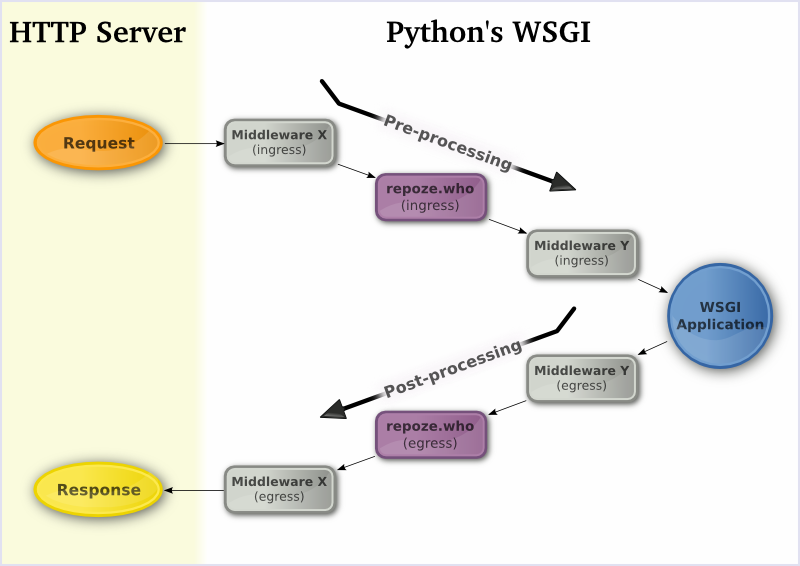Middleware
What is middleware?
Middleware is software that sits in between what receives the request
and the application that returns the response. Middleware may modify
the request or the response or may just observe them. Multiple layers
of middleware may be used.
WSGI Middleware
WSGI is just a contract that applications take an environ
and start_response and return the chunked response
(and call start_response with the appropriate headers).
So it is easy to chain these together.
WSGI middlware obey the WSGI contract and sit between the server
and the endpoint application (which they usually take as an argument to
their constructor).

Though the diagram shows a "wedge"-like structure, any WSGI layer could
branch (i.e. choose between multiple applications/WSGI pipes)
or return a response without talking to the endpoint app(s).
Usually, things don't get too crazy.
How to wrap a WSGI application:
from webob import Request
class MyMiddleware(object):
def __init__(self, app, *args, **kwargs):
self.app = app
# other initialization
# ...
def __call__(self, environ, start_response):
reqeust = Request(environ)
# do stuff
response = request.get_response(self.app)
return response(environ, start_response)
Chains of middleware: factories
Getting a Response with WebOb
You'll often want to modify or introspect a response in a WSGI chain
Use the Request.get_response method:
from webob import Request, Response
class MyMiddleware(object):
def __init__(self, app):
self.app = app
def __call__(self, environ, start_response):
request = Request(environ)
# you might do stuff here
# ...
response = request.get_response(self.app)
response.decode_content()
# do stuff with the response
# ...
# return the response
return response(environ, start_response)
This used to be a tedious by-hand process before webob
What makes good (WSGI) middleware?
-
not reliant on anything else in the chain (likewise, the application
should not be reliant on a particular piece of WSGI middleware being there)
-
should work with all requests/responses
Example middleware service: authorization
WSGI states that the identity (typically, the login name)
of an authenticated user lives in
environ['REMOTE_USER']
(or request.remote_user in webob).
For highly integrated sites, it may be desirable that authentication
is dealt with in an integrated fashion. Typically, however,
the application (or, more generally, downstream middleware + the application)
only cares about who (if anyone) is authenticated. In these cases,
it is a good job for middleware.
Typical middleware authentication workflow:
Example software:
if you use bitsyauth in production, please don't hold me responsible!
it has not been audited for security!
Is this a web service?
probably!
If you use auth, please don't roll your own.
Amongst other things, Apache (and other general-purpose web servers,
such as nginx) is often used to provide HTTP Basic Auth (or digest, etc).
In this sense, amongst others, Apache can function as middleware, albeit
of a non-WSGI variety. The tighter contract of WSGI (vs. HTTP) allows
a richer environment in which to function, assuming you're developing
python web services and sites.
